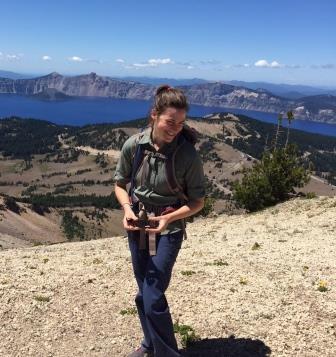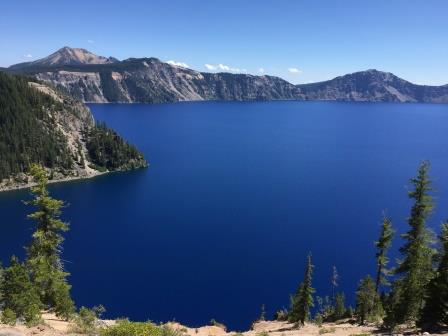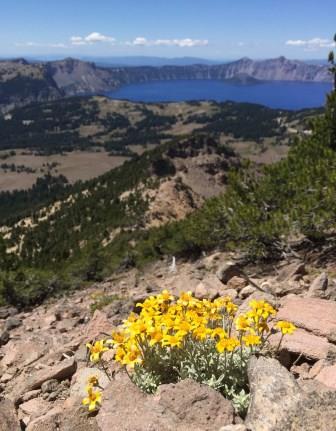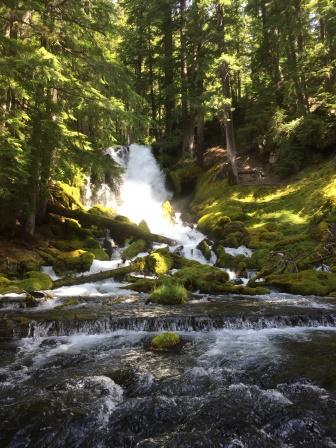
By Julia Haskin
Hello!
M y name is Julia, and I’m a volunteer for Oregon Wild. I primarily work on the Crater Lake Wilderness campaign - the citizens-led push to add a wilderness designation inside the National Park and the lands around it. Many of the big Western parks, like Denali, North Cascades, Mount Rainier, Yosemite, and Olympic, already have wilderness designations. But Crater Lake does not.
y name is Julia, and I’m a volunteer for Oregon Wild. I primarily work on the Crater Lake Wilderness campaign - the citizens-led push to add a wilderness designation inside the National Park and the lands around it. Many of the big Western parks, like Denali, North Cascades, Mount Rainier, Yosemite, and Olympic, already have wilderness designations. But Crater Lake does not.
A wilderness designation provides a greater level of protection, particularly to backcountry areas. Traditional, quiet recreation is allowed, but our influence is limited, allowing the land to recover to more natural patterns. In the case of the Crater Lake Wilderness proposal, benefits would include the creation of a 90-mile wildlife corridor, as well as the protection of 500,000 acres and the headwaters of the Umpqua and Rogue rivers.
 Strangely, however, before last month not only had I never been to Crater Lake, I’d never been to a National Park, full stop. So when I heard about Oregon Wild’s Wild Week - a series of hikes in and around the park over the course of a week, led by Oregon Wild staff - I was excited to participate. Thanks to the kindness of a car-owning friend who was also keen to explore the Crater Lake area, I headed down.
Strangely, however, before last month not only had I never been to Crater Lake, I’d never been to a National Park, full stop. So when I heard about Oregon Wild’s Wild Week - a series of hikes in and around the park over the course of a week, led by Oregon Wild staff - I was excited to participate. Thanks to the kindness of a car-owning friend who was also keen to explore the Crater Lake area, I headed down.
My first view of the lake brought tears to my eyes and a ridiculously large grin to my face. It’s one of the few things that I’ve had a lot of pre-exposure to (you can’t avoid seeing photos of Crater Lake) that not only lived up to, but surpassed the photos. It’s so blue. The depth and vividness of the color puzzles the mind, and in some ways makes it hard to take the lake in. Some part of my brain was always processing the lake as if I were looking at a photo - an edited photo.
It is surreally beautiful.
While the grin recurred every time I looked at the lake, as I explored the area further, details appeared that underscored the need for a wilderness designation. For instance, the views from the top of Mt. Scott - one of the Wild Week hikes - were sweeping panoramas of the lake and the lands surrounding it, most of which are under the aegis of the National Forest Service. And while the lands are currently wooded, the uniformity of tree height and spacing speaks eloquently of their managed state, and of the ever-present potential for clear-cutting. (Take, for instance, the Forest Service’s Bybee logging project just to the west of the park.)
T he interruption of an unseen, but not unheard, helicopter while our group was having lunch at the top of Mt. Scott reminded us how intrusive even distant activities can be in a semi-wild area. None of these ruined the experience for me, but each time, I thought how much richer the experience would be without them.
he interruption of an unseen, but not unheard, helicopter while our group was having lunch at the top of Mt. Scott reminded us how intrusive even distant activities can be in a semi-wild area. None of these ruined the experience for me, but each time, I thought how much richer the experience would be without them.
I went on two hikes with Oregon Wild during the week - one up Mt. Scott, the other along a lovely, if mosquito-y bit of the Upper Rogue River. The hikes began to show me and the wonderful people with whom I hiked just some of the variety of landscape and habitat contained in the area that is within the wilderness proposal.
I intend - and hope that they do, too - to support Oregon Wild and the other organizations and citizens in the coalition spearheading this proposal. Crater Lake truly is a “crown jewel” park, and such a jewel deserves the best setting possible - the setting of wilderness.

 '
'
